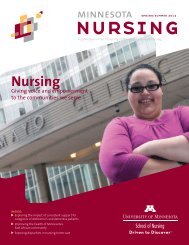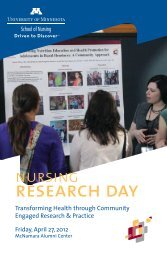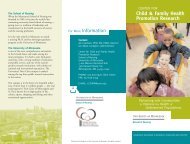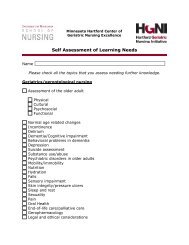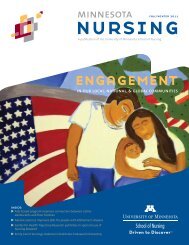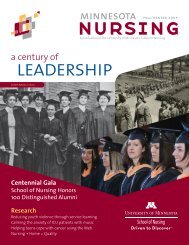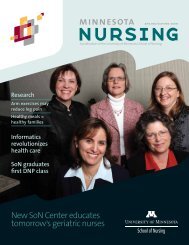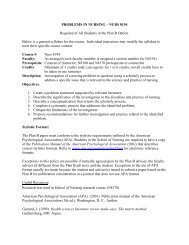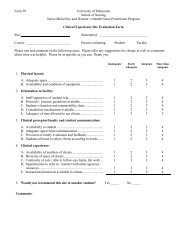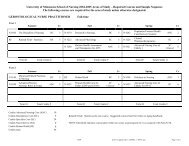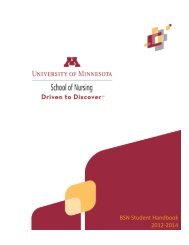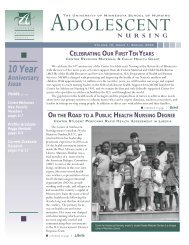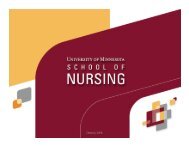Introducing Connie Delaney - School of Nursing - University of ...
Introducing Connie Delaney - School of Nursing - University of ...
Introducing Connie Delaney - School of Nursing - University of ...
You also want an ePaper? Increase the reach of your titles
YUMPU automatically turns print PDFs into web optimized ePapers that Google loves.
esearch<br />
Linda Bearinger, PhD, RN, FAAN<br />
• Public health needs <strong>of</strong> adolescents<br />
• Adolescents’ health education needs for nurses<br />
• Adolescent sexual behavior<br />
• Multiethnic issues in adolescent health<br />
linda bearinger:<br />
pioneering adolescent health<br />
BY MAME OSTEEN<br />
Adolescence can be a rocky and sometimes risky road. When it<br />
comes to health, teenagers’ behavior—rather than disease—is the<br />
major predictor <strong>of</strong> their survival. Bad choices <strong>of</strong>ten send young<br />
people down the path to substance abuse, violence or even death.<br />
Good choices, achieved through guidance, support or early<br />
intervention, can carry them through to successful adulthood.<br />
For the last 10 years, the unique problems associated with<br />
adolescent health have garnered the special study they deserve,<br />
thanks to Linda Bearinger, Pr<strong>of</strong>essor and Director <strong>of</strong> the Center for<br />
Adolescent <strong>Nursing</strong>, in the <strong>School</strong> <strong>of</strong> <strong>Nursing</strong>. The only adolescentspecific<br />
nursing center <strong>of</strong> excellence in the world, Bearinger and<br />
colleagues are bridging the gap between childhood and adulthood<br />
through groundbreaking research on promoting the health <strong>of</strong> teens.<br />
The problem is that health strategies that work well for others<br />
<strong>of</strong>ten don’t work with adolescents. “They need to be developmentally<br />
tailored,” said Bearinger, “because they’re not little adults, and<br />
as any parent would readily say, they are not children—they have<br />
their own unique style.”<br />
NAVIGATING TROUBLED WATERS<br />
Considering the significant problems facing today’s youth, the quest<br />
for understanding is critical. “Fifty years ago if you asked young<br />
people to name their biggest worries, they answered, getting caught<br />
chewing gum, being late for school and getting good grades,” said<br />
Bearinger. “Today, it’s still getting good grades, but it’s now getting<br />
an STD, HIV, or pregnant, and being a victim <strong>of</strong> violence.”<br />
The stress kids face shows in the statistics. Car accidents—twothirds<br />
<strong>of</strong> them alcohol-related—are the leading cause <strong>of</strong> death<br />
among teenagers. Homicide ranks second, followed by suicide.<br />
Strong personal connections are the key to healthy outcomes,<br />
Bearinger says: “It’s about school, it’s about family, and it’s about<br />
peers, and the way communities <strong>of</strong>fer opportunities for young<br />
people. In fact, if I had to only ask one question—it would be about<br />
connection to school. It’s very powerful in <strong>of</strong>fsetting risk.” Knowing<br />
that promoting strong connections is at the core <strong>of</strong> kids doing well,<br />
in all aspects <strong>of</strong> their growing up, Bearinger and colleagues focus<br />
on ways that parents, adults, teachers and youth leaders can<br />
connect effectively with young people during their adolescence.<br />
PLAYING CATCH-UP<br />
Understanding adolescents and passing that knowledge on to<br />
nurses and other health pr<strong>of</strong>essionals is a major objective <strong>of</strong> the<br />
center. An adolescent specialty, which now exists in medicine and<br />
psychology, for example, is newer to nursing—and it shows.<br />
Surveys indicate that more than half the country’s nurses feel ill<br />
equipped to address even common adolescent problems. Since the<br />
center was founded in 1993, Bearinger and her adolescent nursing<br />
faculty colleagues have worked hard to alleviate that problem.<br />
“We’re trying to bridge the gap between nurses’ skills and<br />
knowledge and the health problems <strong>of</strong> youth,” said Bearinger.<br />
As the only federally funded graduate and post-graduate<br />
program focusing on adolescent health for nurses, the center has<br />
expanded knowledge <strong>of</strong> the field through the research <strong>of</strong> its<br />
growing faculty and research scientists, who now number six. The<br />
center’s resources support stipends and tuition for its master’s and<br />
doctoral students and post-doctoral research fellows. The center<br />
just welcomed its eighth doctoral student; three graduates who<br />
have joined faculties in schools <strong>of</strong> nursing are, in turn, teaching<br />
other nurses about effective way to work with teens.<br />
The center’s outreach efforts connect nurses around the country<br />
and around the world to issues in adolescent care. More than a<br />
thousand health care providers worldwide receive the center’s<br />
16 minnesota nursing



